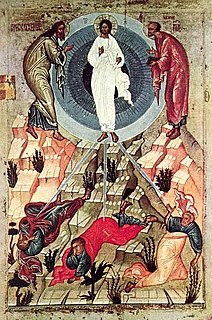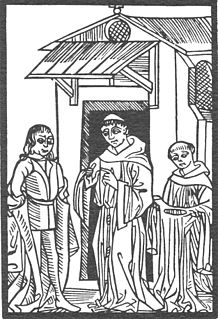 W
WA dream vision or visio is a literary device in which a dream or vision is recounted as having revealed knowledge or a truth that is not available to the dreamer or visionary in a normal waking state. While dreams occur frequently throughout the history of literature, visionary literature as a genre began to flourish suddenly, and is especially characteristic in early medieval Europe. In both its ancient and medieval form, the dream vision is often felt to be of divine origin. The genre reemerged in the era of Romanticism, when dreams were regarded as creative gateways to imaginative possibilities beyond rational calculation.
 W
WThe Book of the Nine Rocks is an anonymous 14th century German mystical text.
 W
WThe Cloud of Unknowing is an anonymous work of Christian mysticism written in Middle English in the latter half of the 14th century. The text is a spiritual guide on contemplative prayer in the late Middle Ages. The underlying message of this work suggests that the way to know God is to abandon consideration of God's particular activities and attributes, and be courageous enough to surrender one's mind and ego to the realm of "unknowing", at which point one may begin to glimpse the nature of God.
 W
WThe Consolation of Philosophy is a philosophical work by the Roman statesman Boethius, written around the year 524. It has been described as the single most important and influential work in the West on Medieval and early Renaissance Christianity, as well as the last great Western work of the Classical Period.
 W
WThe Light upon the Candlestick is an anonymous mystical tract published in Holland in 1662. Translated into English in 1663, it became a popular text among English Quakers.
 W
WThe Mirror of Simple Souls is an early 14th-century work of Christian mysticism by Marguerite Porete dealing with the workings of Divine Love.Love in this book layeth to souls the touches of his divine works privily hid under dark speech, so that they should taste the deeper draughts of his love and drink.
 W
WThe Myth of Er is a legend that concludes Plato's Republic (10.614–10.621). The story includes an account of the cosmos and the afterlife that greatly influenced religious, philosophical, and scientific thought for many centuries.
 W
WThe Sister Catherine Treatise is a work of Medieval Christian mysticism seen as representative of the Heresy of the Free Spirit of the thirteenth and fourteenth centuries in Europe. Wrongly attributed to Christian mystic Meister Eckhart it nevertheless shows the influence of his ideas, or at least the ideas which he was accused or attributed as having had by the Inquisition.
 W
WThe Dream of Scipio, written by Cicero, is the sixth book of De re publica, and describes a fictional dream vision of the Roman general Scipio Aemilianus, set two years before he oversaw the destruction of Carthage in 146 BC.
 W
WTractatus de Purgatorio Sancti Patricii is a Latin text written about 1180–1184 by a monk who identified himself as H. of Saltrey. The author is traditionally known as Henry, and was a Cistercian in Huntingdonshire.
 W
WThe Visio Karoli Crassi or Visio Karoli Grossi, also called the Visio Karoli (Tertii) Imperatoris, is an anonymous work of Latin prose from around 900. It was composed at Reims and depicts a vision of his ancestors warning the Emperor Charles the Fat of the coming downfall of his family, the Carolingians.
 W
WThe Visio Tnugdali is a 12th-century religious text reporting the otherworldly vision of the Irish knight Tnugdalus. It was "the most popular and elaborate text in the medieval genre of visionary infernal literature" and had been translated from the original Latin forty-three times into fifteen languages by the 15th century, including Icelandic and Belarusian. The work remained most popular in Germany, with ten different translations into German, and four into Dutch. With a recent resurgence of scholarly interest in Purgatory following works by Jacques Le Goff, Stephen Greenblatt and others, the vision has attracted increased academic attention.